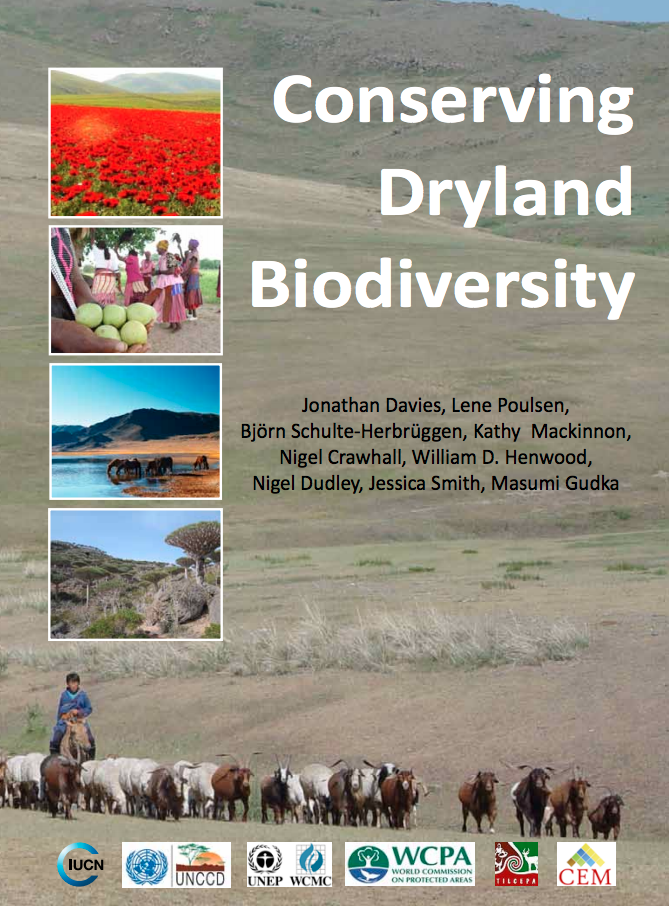Resource information
Dryland biodiversity is of tremendous global importance, being central to the well-being and development of millions of people in developing countries. In June 2012, at the UN Conference on Sustainable Development (or “Rio+20”), global leaders from governments and civil society reaffirmed the intrinsic value of biological diversity and recognised the severity of global biodiversity loss and degradation of ecosystems. Although drylands were implicitly recognised, there continues to be inadequate attention to this major biome that covers such a vast part of our world’s terrestrial surface. Yet, as this book conveys, conservation and sustainable management of drylands biodiversity offers a viable pathway to deliver international conservation and development targets. This book is a global resource aimed to aide dryland management as it is the first comprehensive analysis of dryland biodiversity that is of global importance and significance.
Many people in the drylands pursue livelihoods that conserve biological diversity in innovative ways, and often with little recognition. Farmers in the Sahel for instance practice cultivation and agro-forestry techniques that not only improve productivity and strengthen resilience, but also provide family income and numerous environmental benefits. Mobile pastoralists in many dryland regions maintain herding strategies that mimic nature, thereby promoting ecosystem functions that not only underpin their livelihood but also provide global environmental benefits like carbon sequestration and species conservation.
IUCN, the International Union for Conservation of Nature, is strongly committed to the conservation and sustainable management of drylands biodiversity. As a Union of more than 200 government organisations and over 900 non-government organisations, as well six Commissions of 11,000 voluntary scientists and experts, IUCN is strongly positioned to champion dryland biodiversity and to demonstrate and promote innovative ways to achieve the shared goals of biodiversity conservation and sustainable development.
The United Nations Convention to Combat Desertification, as the international legally binding agreement on desertification and land degradation, recognizes that actions taken to combat desertification/land degradation and drought, and actions taken to promote biological diversity are inextricably linked in both purpose and effect. Working to improve both the livelihoods of dryland populations and the conditions of such ecosystems, the UNCCD delivers on this mandate particularly by advocating the need, and demonstrating the ways, to maintain and restore land and soil productivity and to mitigate the effects of drought. Aware of the inter-linkages between biodiversity, land and soil productivity and human well-being, the Convention acts to raise awareness on drylands biodiversity and its value, including species diversity, habitat and ecosystems. Additionally, it takes action to offset land degradation through effective ways of conserving and restoring dryland biodiversity. And indeed, the world came out of the Rio+20 Summit with an international resolve to achieve a land degradation neutral world, to be pursued with the implementation and promotion of sustainable land management practices worldwide.
For the United Nations Environment Programme, drylands biodiversity is a cross-cutting priority throughout its work on ecosystem management, environmental governance, early warning and assessment, and beyond. UNEP chairs and hosts the Environment Management Group, a UN system wide coordinating body which catalyses and coordinates action on important environment and human settlement issues. In 2011 the UN released the EMGsupported Global Drylands: A UN System-wide Response, which commits the entirety of the UN system to step up their efforts to protect and revitalise drylands, and improve the well-being of drylands communities, through a pro-active drylands development and investment approach.
Conserving Dryland Biodiversity is intended to raise awareness amongst all stakeholders and galvanise wider action to boost drylands conservation and development. It is a call to action as well as a guide to how dryland conservation and development can be equitably pursued. The book is designed to inform and remind us of the beauty of dryland biodiversity and its intrinsic and instrumental value. It demonstrates the mutual dependency of dryland biological and cultural diversity. The book includes new analyses of drylands biodiversity and an overview of approaches that promote sustainable development as well as conservation goals. It strongly underlines the importance of indigenous knowledge and culture to dryland conservation, and demonstrates an unrivalled opportunity for sustainable growth and biodiversity protection.
The commitment of global leaders cannot be translated into reality if the drylands are neglected or continue to be misunderstood. If historic underinvestment in the drylands is addressed and knowledge gaps are closed then dryland conservation will enable us to greatly exceed our global expectations. We, as heads of our respective institutions, are proud of this effort and we are committed to working, together and with others, to realise the worthy and vital ambitions outlined in this book.


